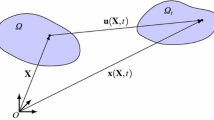Abstract
The numerical prediction of the dynamic behaviour of mechanical systems subjected to friction-induced vibrations is still a tedious problem. Different methodologies exist nowadays to study it. The first one is the complex eigenvalue analysis, which is widely used by the scientists and the industrials to predict the appearance of instabilities despite its disadvantages. Other methodologies, namely temporal integration and frequential approaches, have been developed to determine the transient and/or the steady-state response to assess the history of the dynamic response, and so to identify the unstable modes involved in the nonlinear dynamic response as well as the vibration levels. However, because of their complex implementation, their high numerical cost and sometimes the strong assumptions made on the form of the solutions, these methods are not widely and currently used in industry. To cope with the limitations of the CEA, namely the over- or under-predictability and the lack of information about modal participations in the nonlinear dynamic response, developing complementary tools is necessary. Thus, this paper is devoted to the extension and generalization of a nonlinear approach, called the modal amplitude stability analysis, to the multi-instability case. The method, called the Generalized Modal Amplitude Stability Analysis (GMASA), allows to identify the evolutions and contributions of unstable modes involved in the nonlinear self-sustaining vibration response and to estimate the limit cycles. The method is applied on a phenomenological system for which it is easy to provide an understanding of the unstable mode(s) contribution to the nonlinear dynamic response of the system and for which the calculations can be performed with reasonable computational times. Thus, the efficiency and validity of the GMASA approach are investigated by comparing the GMASA results with those of the reference results based on temporal approach.










Similar content being viewed by others
References
Kinkaid, N.M., O’Reilly, O., Papadopoulos, P.: Automotive disc brake squeal. J. Sound Vib. 267(1), 105–166 (2003)
Ouyang, H., Nack, W., Yuan, Y., Chen, F.: Numerical analysis of automotive disc brake squeal: a review. Int. J. Veh. Noise Vib. 1(3–4), 207–231 (2005)
Papinniemi, A., Lai, J.C.S., Zhao, J., Loader, L.: Brake squeal: a literature review. Appl. Acoust. 63(4), 391–400 (2002)
Ibrahim, R.A.: Friction-induced vibration, chatter, squeal, and chaos—part ii: dynamics and modeling. Appl. Mech. Rev. 47(7), 227–253 (1994)
Spurr, R.T.: A theory of brake squeal. Proc. Inst. Mech. Eng. Autom. Div. 15(1), 33–52 (1961)
Hulten, J.: Brake squeal-a self-exciting mechanism with constant friction. Technical report, SAE technical paper (1993)
Hoffmann, N., Fischer, M., Allgaier, R., Gaul, L.: A minimal model for studying properties of the mode-coupling type instability in friction induced oscillations. Mech. Res. Commun. 29(4), 197–205 (2002)
North, M.R.: Disc Brake Squeal—A Theoretical Model. MIRA, Noneaton (1972)
Sinou, J.-J.: Transient non-linear dynamic analysis of automotive disc brake squeal-on the need to consider both stability and non-linear analysis. Mech. Res. Commun. 37(1), 96–105 (2010)
Oberst, S., Lai, J.C.S.: Statistical analysis of brake squeal noise. J. Sound Vib. 330(2), 2978–2994 (2011)
Oberst, S., Lai, J.C.S.: Nonlinear transient and chaotic interactions in disc brake squeal. J. Sound Vib. 342, 272–289 (2015)
Lorang, X., Chiello, O.: Stability and transient analysis in the modelling of railway disc brake squeal. In: Noise and Vibration Mitigation for Rail Transportation Systems, pp. 447–453. Springer, Berlin (2008)
Massi, F., Baillet, L., Giannini, O., Sestieri, A.: Brake squeal: linear and nonlinear numerical approaches. Mech. Syst. Signal Process. 21(6), 2374–2393 (2007)
AbuBakar, A.R., Ouyang, H.: Complex eigenvalue analysis and dynamic transient analysis in predicting disc brake squeal. Int. J. Veh. Noise Vib. 2(2), 143–155 (2006)
Vermot des Roches, G.: Frequency and time simulation of squeal instabilities. Application to the design of industrial automotive brakes. Ph.D. thesis, École Centrale Paris, Châtenay-Malabry, France (2011)
Coudeyras, N., Sinou, J.-J., Nacivet, S.: A new treatment for predicting the self-excited vibrations of nonlinear systems with frictional interfaces: the constrained harmonic balance method, with application to disc brake squeal. J. Sound Vib. 319(3–5), 1175–1199 (2009)
Nayfeh, A., Balachandran, B.: Applied Nonlinear Dynamics: Analytical, Computational, and Experimental Methods. Wiley, Hoboken (2008)
Charroyer, L., Chiello, O., Sinou, J.-J.: Self-excited vibrations of a non-smooth contact dynamical system with planar friction based on the shooting method. Int. J. Mech. Sci. 144, 90–101 (2018)
Brunetti, J., Massi, F., Berthier, Y.: A new instability index for unstable mode selection in squeal prediction by complex eigenvalue analysis. J. Sound Vib. 377, 106–122 (2016)
Nacivet, S., Sinou, J.-J.: Modal amplitude stability analysis and its application to brake squeal. Appl. Acoust. 116, 127–138 (2017)
Kim, Y.B., Choi, S.K.: A multiple harmonic balance method for the internal resonant vibration of a non-linear jeffcott rotor. J. Sound Vib. 208(5), 745–761 (1997)
Cameron, T.M., Griffin, J.H.: An alternating frequency/time domain method for calculating the steady-state response of nonlinear dynamic systems. J. Appl. Mech. 56(1), 149–154 (1989)
Hulten, J.: Friction phenomena related to drum brake squeal instabilities. In: Proceedings of ASME Design Engineering Technical Conferences, 16th ASME Biennial Conference on Mechanical Vibration and Noise (1997)
Dakel, M., Sinou, J.-J.: Stability and nonlinear self-excited friction-induced vibrations for a minimal model subjected to multiple coalescence patterns. J. Vibroeng. 19(1), 604–628 (2017)
Acknowledgements
This work was achieved within PSA Peugeot Citroën Stellab program—OpenLab Vibro-Acoustic-Tribology@Lyon (VAT@Lyon). J.-J. Sinou acknowledges the support of the Institut Universitaire de France.
Author information
Authors and Affiliations
Corresponding author
Ethics declarations
Conflict of interest
The authors declare that they have no conflict of interest.
Additional information
Publisher's Note
Springer Nature remains neutral with regard to jurisdictional claims in published maps and institutional affiliations.
Rights and permissions
About this article
Cite this article
Denimal, E., Sinou, JJ. & Nacivet, S. Generalized Modal Amplitude Stability Analysis for the prediction of the nonlinear dynamic response of mechanical systems subjected to friction-induced vibrations. Nonlinear Dyn 100, 3121–3144 (2020). https://doi.org/10.1007/s11071-020-05627-1
Received:
Accepted:
Published:
Issue Date:
DOI: https://doi.org/10.1007/s11071-020-05627-1




